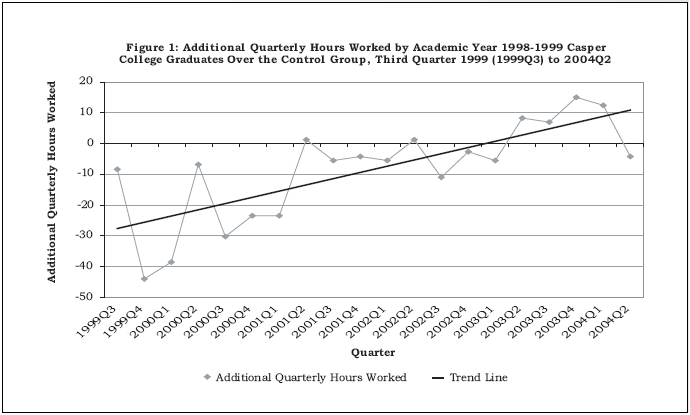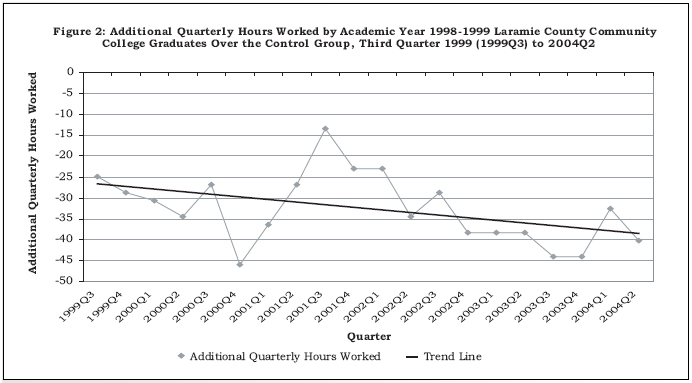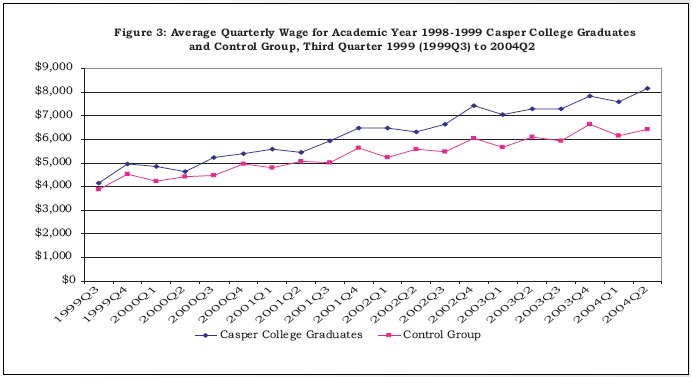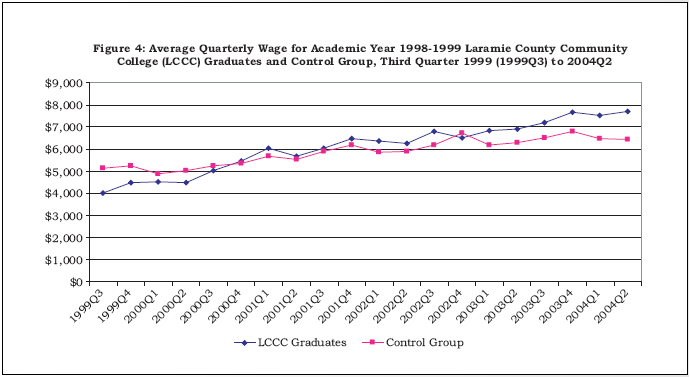Return to text

Return to text

Return to text

Return to text

© Copyright 2006 by the Wyoming Department of Employment, Research & Planning
Vol. 43 No. 2
When graduates work in Wyoming, employers are able to make use of the educational investment, but when they do not work in Wyoming, the investment is not realized by the state. Research & Planning found that wages for both Casper College and LCCC graduates were higher than those for their respective matched control groups and the difference increased over time.
One of the missions of a community college is to teach skills needed by the local labor market. Ideally, the local labor market compensates adequately for those skills. Provided that graduates supply skills that businesses want and businesses compensate accordingly, the result should be higher rates of subsequent labor market participation for graduates in comparison to similar individuals who did not graduate from a community college. When graduates work in Wyoming, employers are able to make use of the educational investment, but when they do not work in Wyoming, the investment is not realized by the state. We ask whether empirical evidence demonstrates that graduates have a higher degree of involvement in Wyoming’s labor market after graduation when compared to matched control groups. We also seek to determine the dollar value of their contribution to Wyoming’s labor market.
Methods
Herein, involvement is defined as the number of graduates who worked in Wyoming during a quarter. In this case, we examined 20 quarters (5 years) of Wage Records (Gosar, 1995) activity subsequent to graduation for each student and calculated the corresponding hours per quarter (assuming a 40-hour work week). Wages were adjusted to second quarter 2004 (2004Q2) dollars using the Consumer Price Index for All Urban Consumers (CPI-U). These measures demonstrate contributions that community college graduates make to Wyoming’s labor market.
Given that a number of graduates take several quarters to find work in which they establish a continuous working relationship with employers (Saulcy, 2004), measures of work activity taken shortly after graduation may be problematic. Therefore, this article examines labor market involvement during the 5-year period after graduation. Available data are limited to academic year 1998-1999 (AY98-99) Casper College and Laramie County Community College (LCCC) graduates (N = 378 and 272, respectively).
Control groups were drawn by matching age, gender, prior involvement in Wyoming’s labor market (the reference quarter for matching occurred two quarters prior to graduation), and geographic location (i.e., controls were restricted to Natrona and Laramie County residents, respectively). All three graduating classes were included (i.e., summer, winter, and spring). The control group methodology used is substantively similar to that elaborated by Glover (2002).
Theoretical Considerations
Given that Casper and Cheyenne have very different social and economic environments, the outcomes were examined separately for each school and control group members were restricted to Natrona and Laramie County residents, respectively. Casper is located in the center of Wyoming and is geographically distant from major metropolitan areas such as Billings, Denver, and Salt Lake City. Cheyenne, on the other hand, is a border city in close proximity to Colorado’s Front Range.
Results Quarterly Hours Contributed
Casper College graduates initially contributed fewer hours per quarter to Wyoming’s economy than their matched control group (see Figure 1). However, the trend line indicates that they gained ground on the Natrona County controls over time and surpassed them at about 2003Q2. Additional hours contributed increased by about 40 hours per graduate per quarter. LCCC graduates contributed fewer quarterly hours to Wyoming than their matched control group throughout the entire time series. The trend line on Figure 2 indicates that the number of quarterly hours continued to decrease over the 5-year period by about 15 quarterly hours per graduate. The notable exception is the period from 2001Q3 to 2002Q1, a time of significant economic downturn in Colorado, when graduate and control group hours became more similar (i.e., closer to zero). Wages
Casper College graduates had higher wages than the Natrona County matched control group throughout the 5-year period (see Figure 3) with the difference increasing considerably over time. LCCC students entered the labor market with lower wages than the Laramie County control group but surpassed the control group by 2001Q1 (see Figure 4). Over time the gap between LCCC graduates and the control group continued to increase. The wages for Casper College and LCCC graduates were similar. They both started (1999Q3) at about $4,000 per quarter per graduate (in constant 2004Q4 dollars) and increased to about $8,000 by 2004Q3.
Discussion and Conclusion
There may be several possible explanations for graduate non-involvement in the labor market. Perhaps a mismatch exists between graduates’ skills employers’ needs, or there may simply be too few jobs in the local labor market for the added supply from the colleges. Graduates may look elsewhere for employment if employers are not compensating adequately for earned skills. Additionally, graduates may have earned a degree for personal fulfillment with no intention of seeking employment or they may have transferred to another educational institution. Examining the reasons behind non-participation in Wyoming’s labor market is beyond the scope of this study.
Results presented here indicate that graduates from Casper College experience higher levels of involvement in Wyoming’s labor market in comparison to a Natrona County control group than do students from LCCC in comparison to their matched control group.
It appears that Casper College may prepare students to better compete in the local labor market than their corresponding Natrona County control group. Because the local labor market is more geographically restricted to Natrona and surrounding counties, they may be more likely to stay in Wyoming. LCCC may also prepare its students to compete well in the labor market, but their local labor market extends into the Front Range of Colorado. Proximity to a large labor market provides additional quality job opportunities to LCCC graduates that many not be as readily available to Laramie County controls without a degree. This competitive disadvantage results in restricting control group members’ employment opportunities to Wyoming.
Wages for both Casper College and LCCC graduates are higher than those for their respective matched control groups and the difference increases over time.
References
Glover, T. (2002, June). Compared to what? The purpose and method of control group selection. Wyoming Labor Force Trends. Retrieved July 26, 2005, from http://doe.state.wy.us/LMI/0602/a2.htm
Gosar, W. (1995, May). Wyoming unemployment insurance wage record summary statistics: A new way to look at Wyoming. Wyoming Labor Force Trends. Retrieved August 19, 2005, from http://doe.state.wy.us/LMI/0595/0595a2.htm
Saulcy, S. (2004, August). Chapter 4: Results From Survey Data. In Where are they now? Wyoming community college graduates’ labor market outcomes 2004. Retrieved July 26, 2005, from http://doe.state.wy.us/LMI/CollegeReport2004.htm
Return to text

Return to text

Return to text

Return to text

Table of Contents | Labor Market Information | Wyoming Job Network | Send Us Mail
These pages designed by Julie Barnish.
Last modified on
by Phil Ellsworth.